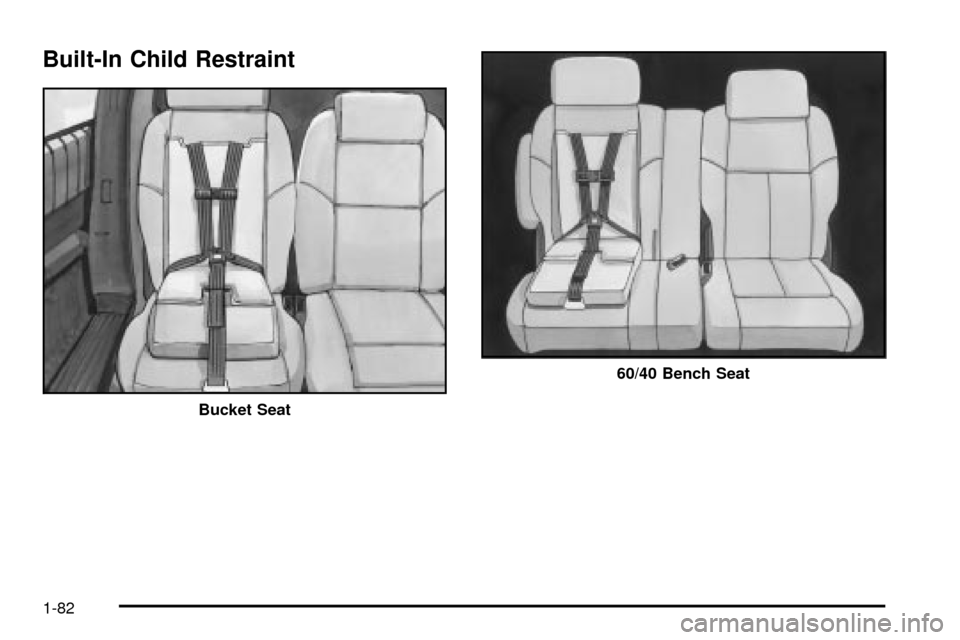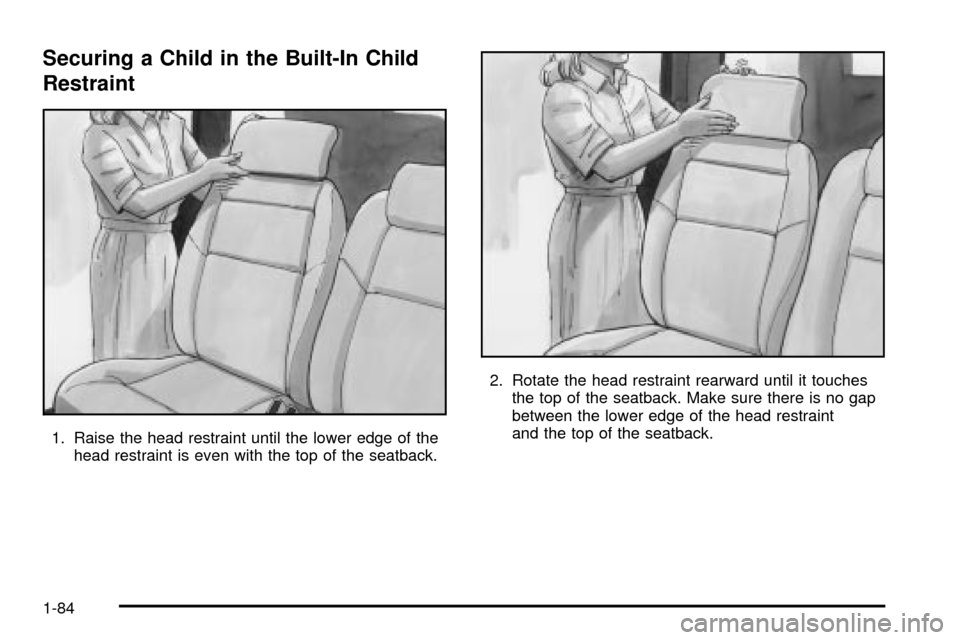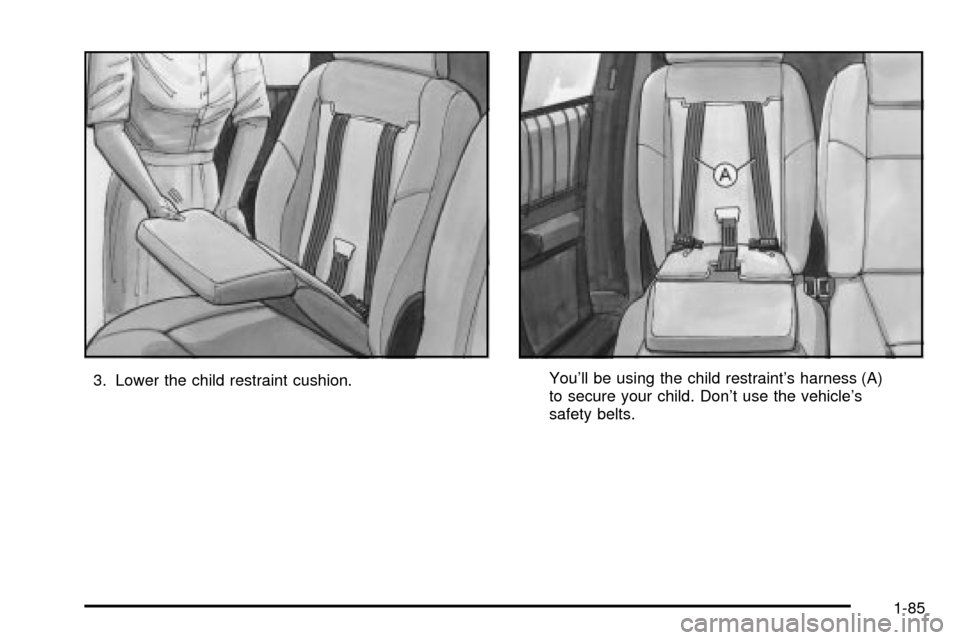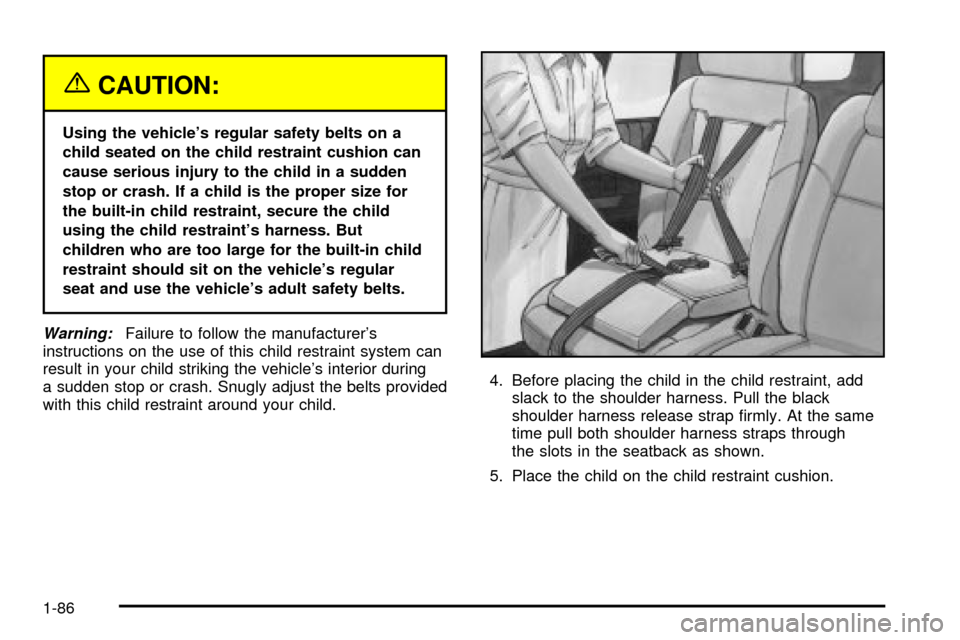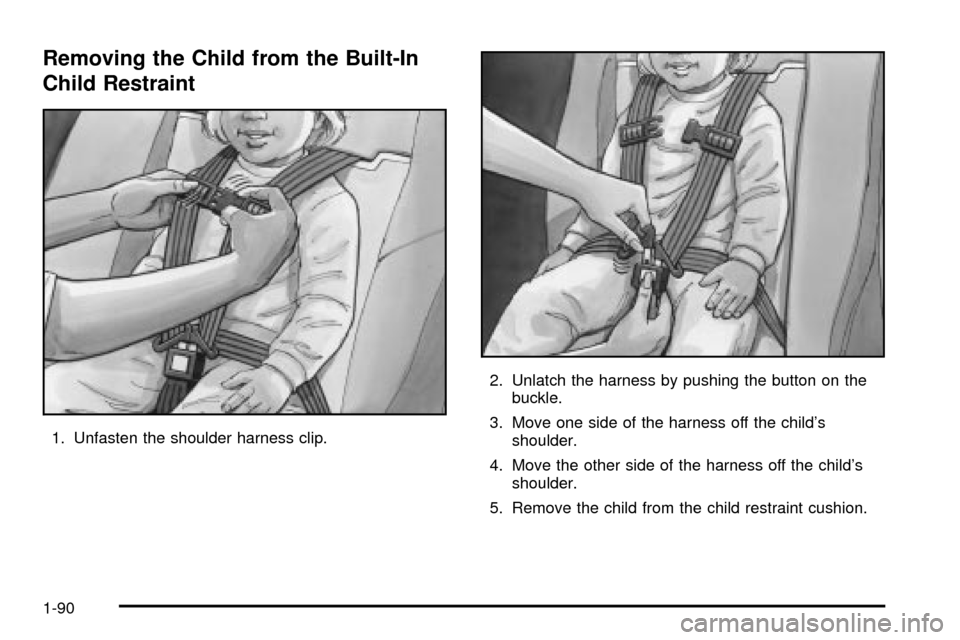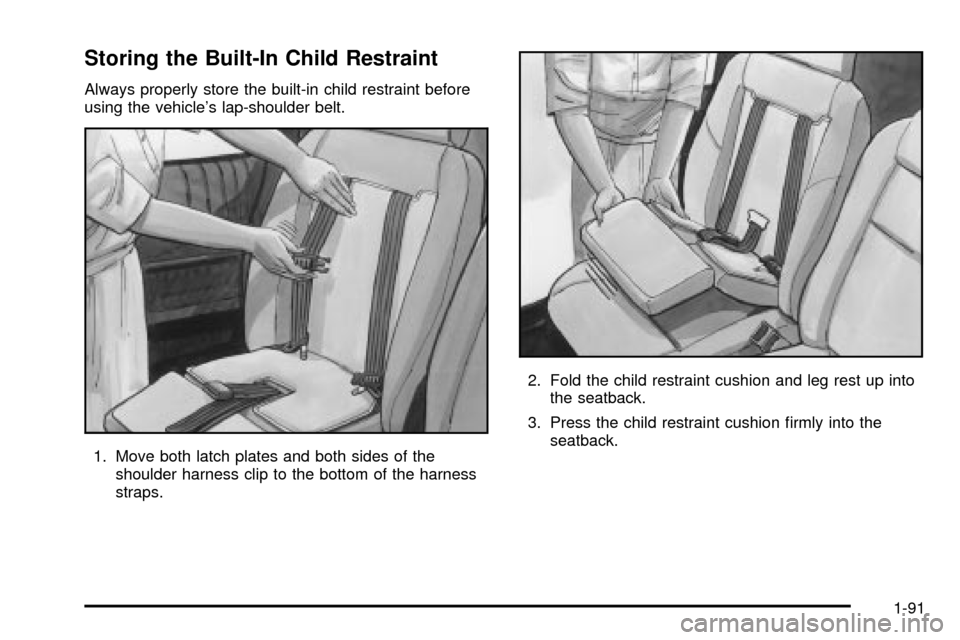CHEVROLET VENTURE 2003 1.G Owner's Guide
VENTURE 2003 1.G
CHEVROLET
CHEVROLET
https://www.carmanualsonline.info/img/24/8380/w960_8380-0.png
CHEVROLET VENTURE 2003 1.G Owner's Guide
Page 87 of 486
5. Pull the rest of the lap belt all the way out of the
retractor to set the lock.6. To tighten the belt, feed the shoulder belt back into
the retractor while you push down on the child
restraint. You may ®nd it helpful to use your knee to
push down on the child restraint as you tighten
the belt.
7. Push and pull the child restraint in different
directions to be sure it is secure.
To remove the child restraint, just unbuckle the vehicle's
safety belt and let it go back all the way. The safety
belt will move freely again and be ready to work for an
adult or larger child passenger.
1-81
Page 88 of 486
Built-In Child Restraint
Bucket Seat
60/40 Bench Seat
1-82
Page 89 of 486

If your vehicle has this option in a bucket seat, each
bucket seat that has the built-in child restraint ®ts in only
one location in your vehicle. To ®nd out where a
bucket seat that has a built-in child restraint must be
located in your vehicle see
Rear Seat Operation
on page 1-7. If your vehicle has this option in a 60/40
bench seat, this bench seat will only ®t in the second
row of your vehicle. In both types of seats, the built-in
child restraint works the same way.
This child restraint system conforms to all applicable
Federal Motor Vehicle Safety Standards.
Each child restraint is designed for use only by children
who weigh between 22 and 40 pounds (10 and 18 kg)
and whose height is between 33.5 and 40 inches
(850 and 1 016 mm) and who are capable of sitting
upright alone.
The child should also be at least one year old. It is
important to use a rear-facing infant restraint until the
child is about a year old. A rear-facing restraint gives the
infant's head, neck and body the support they would
need in a crash. See
Older Children on page 1-55orInfants and Young Children on page 1-58.
Q:What if the top of my child's shoulders is above
the shoulder belt slots for the ®ve-point child
restraint harness system?
A:A child whose shoulders are above the shoulder
belt slots for the ®ve point child restraint harness
system shouldn't use this child restraint. Instead,
the child should sit on the vehicle's regular
seat cushion and use the vehicle's adult
safety belts.
{CAUTION:
BEFORE YOU USE THIS CHILD RESTRAINT,
BE SURE THE TOP OF THE CHILD'S
SHOULDERS IS BELOW THE SLOTS THAT
THE HARNESS GOES THROUGH. A CHILD
WHOSE SHOULDERS ARE ABOVE THOSE
SLOTS COULD BE INJURED DURING A
SUDDEN STOP OR CRASH. IF THE TOP OF
THE CHILD'S SHOULDERS IS ABOVE THE
SLOTS, DON'T USE THIS CHILD RESTRAINT
WHILE THE VEHICLE IS IN MOTION.
1-83
Page 90 of 486
Securing a Child in the Built-In Child
Restraint
1. Raise the head restraint until the lower edge of the
head restraint is even with the top of the seatback.2. Rotate the head restraint rearward until it touches
the top of the seatback. Make sure there is no gap
between the lower edge of the head restraint
and the top of the seatback.
1-84
Page 91 of 486
3. Lower the child restraint cushion.You'll be using the child restraint's harness (A)
to secure your child. Don't use the vehicle's
safety belts.
1-85
Page 92 of 486
{CAUTION:
Using the vehicle's regular safety belts on a
child seated on the child restraint cushion can
cause serious injury to the child in a sudden
stop or crash. If a child is the proper size for
the built-in child restraint, secure the child
using the child restraint's harness. But
children who are too large for the built-in child
restraint should sit on the vehicle's regular
seat and use the vehicle's adult safety belts.
Warning:Failure to follow the manufacturer's
instructions on the use of this child restraint system can
result in your child striking the vehicle's interior during
a sudden stop or crash. Snugly adjust the belts provided
with this child restraint around your child.4. Before placing the child in the child restraint, add
slack to the shoulder harness. Pull the black
shoulder harness release strap ®rmly. At the same
time pull both shoulder harness straps through
the slots in the seatback as shown.
5. Place the child on the child restraint cushion.
1-86
Page 93 of 486
6. Select only one side of the harness. Place the
harness over the child's shoulder.
7. Push the latch plate (B) into the buckle until it
clicks.
Be sure the buckle is free of any foreign objects
that may prevent you from securing the latch plates.
If you can't secure a latch plate, see your dealer
for service before using the child restraint.8. Place the other side of the harness over the child's
shoulder.
9. Push the latch plate into the buckle until it clicks.
10. Pull up on the latch plates to make sure they are
secure.
1-87
Page 96 of 486
Removing the Child from the Built-In
Child Restraint
1. Unfasten the shoulder harness clip.2. Unlatch the harness by pushing the button on the
buckle.
3. Move one side of the harness off the child's
shoulder.
4. Move the other side of the harness off the child's
shoulder.
5. Remove the child from the child restraint cushion.
1-90
Page 97 of 486
Storing the Built-In Child Restraint
Always properly store the built-in child restraint before
using the vehicle's lap-shoulder belt.
1. Move both latch plates and both sides of the
shoulder harness clip to the bottom of the harness
straps.2. Fold the child restraint cushion and leg rest up into
the seatback.
3. Press the child restraint cushion ®rmly into the
seatback.
1-91
Page 98 of 486
4. Then press the leg rest ®rmly into the seatback,
and secure it by pressing the upper corners
against the fastener strips on the seatback.5. Rotate the head restraint forward and push it all the
way down.
Just like the other restraint systems in your vehicle, your
built-in child restraint needs to be periodically checked
and may need to have parts replaced after a crash. See
Checking Your Restraint Systems on page 1-103andReplacing Restraint System Parts After a Crash on
page 1-104.
1-92

